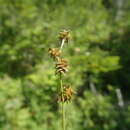Description
provided by eFloras
Culms 10–110 cm. Leaves 3–5 per culm; sheaths tight, inner band hyaline, 3.5–24 cm, apex concave, glabrous; ligules rounded to obtuse, 0.5–3.7 mm; blades plicate, 8–60 cm × 0.4–4(–4.5) mm, widest leaf 0.8–4(–4.5) mm wide. Inflorescences 0.8–5.5 cm; spikes 2–8; lateral spikes pistillate often with a few staminate flowers proximally, 3.1–13.1 mm, sessile, staminate portion 10-flowered, to 6.5 mm, pistillate portion 3–40-flowered, 2.5–12 mm; basal 2 spikes 1.5–18 mm apart; terminal spike gynecandrous, 4.8–23.7 mm, staminate portion 2–21-flowered, 1.8–13.5 × 0.8–1.3 mm, pistillate portion 4–38-flowered, 3–11 × 4.4–7.5 mm. Pistillate scales ovate to ± suborbicular, 1.2–2.4 × 1.2–2 mm, apex obtuse to acute. Staminate scales ovate-lanceolate to ovate, 1.3–3.5 × 0.8–1.4 mm, base clavate, apex acute to obtuse. Anthers 0.6–1.5(–1.8) mm. Perigynia spreading to reflexed, green, 6–13-veined abaxially, (0–)1–12-veined adaxially over achene, broadly ovate to suborbicular, cuneate or concavely tapered from widest point to beak, 1.9–3.8 × (1.3–)2.1–3 mm, 1.1–1.7(–1.9) times as long as wide; beak 0.45–1.25 mm, 0.23–0.5(–0.63) length of body, serrulate, teeth 0.15–0.45 mm. Achenes deltate to rhombic-orbiculate, 1–1.9 × 1–1.7 mm.
- license
- cc-by-nc-sa-3.0
- copyright
- Missouri Botanical Garden, 4344 Shaw Boulevard, St. Louis, MO, 63110 USA
Synonym
provided by eFloras
Carex stellulata Goodenough var. conferta Chapman, Fl. South. U.S., 534. 1860, not C. conferta Hochstetter ex A. Richard 1850
- license
- cc-by-nc-sa-3.0
- copyright
- Missouri Botanical Garden, 4344 Shaw Boulevard, St. Louis, MO, 63110 USA
Comprehensive Description
provided by North American Flora
Carex atlantica L. H. Bailey, Bull. Torrey Club 20: 425. 1893
Carex stellulata var. conferla Chapm. PI. S. U. S. 534. I860. (Type from Apalachicola, Florida.) Carex echinata var. conferla L. H. Bailey Cat. N. Am. Car. 2. 1SS4. (Based on C. stellulata var.
conferla Chapm. "Carex sterilis Willd." Fernald, Proc. Am. Acad. 37: 484. 1902.
Very densely cespitose, the rootstocks not at all prolonged, dark-colored, fibrillose, the clumps large, the culms usually 2-7 dm. high, stiff, thickish (2-3.5 mm.) at base, obtu i Ij triangular below, less so and roughened on the angles above, usually exceeded by the long leaves, light-brown at base, and clothed with the dried-tip leaves of the previous year, the lower short-bladed or bladcless; leaves of the year with well-developed blades usually 3 or I to a fertile culm, on the lower third, but not bunched, the blades erect, light-green, firm, canaliculate, 2.5-4 dm. long, 1.5-4 mm. wide usually about 2.5 mm. wide), roughened on margins and towards apex, the sheaths tight, hyaline ventrally, concave or truncate and villi brown-tinged and thickened at mouth, the ligule wider than long; spikes 3 5, more or less separate, rarely aggregated in a strict terminal head 2-6 cm long, the spikes 6 7 mm wide and containing 8 — to at length widely spreading perigynia, the terminal gynaecandrous, 8-15 mm long, strongly clavate at base, the lateral fl 12 mm long and entirely pi til scale-like or the low I ofti d prolonged but much shorter than bea tti orbicular,
typically obt lally slightly acutish, narrower lliati and only lialf length "I bo
perigynia, light-yellowish brown tinged, with p hyaline
margin, rounded on back and not sharply keeled, the midvein becomirj
staminate scales similar, perigynia concavo convex, piano convex, or even slightly biconvex,
very broadly ovat'or uborbirular, broadest just above base, ' mn Ltly more tli. in 2 mm. wide, thick,
until over-ripe, itrongry many nerved doraally and rtronglj ed ventrally, the lowir p. : rdate or bun ibruptly narro
of body, obliquely deft dor Jly, yello tipped, biden' oth doi al futuri and falsi ventral tutur prominent. the dorsal white-margined; achenes lenticular, occupying upper part of bodies of perigynia, slightly stipitate, short-apiculate, ovate-suborbicular, 1.75 mm. long, nearly as wide; style short, somewhat enlarged at base, jointed with achene, at length deciduous; stigmas two, light-reddish-brown, slender, rather short.
Type locality: "Pine barren swamps." (Chapman's specimens of C. stellulala var. conferta Chapm., on which C. atlantica is based, came from Apalachicola, Florida.)
Distribution: Acid soils, pine barren bogs, mostly on the coastal plain. Nova Scotia to Florida and Texas. (Specimens examined from New Brunswick, Nova Scotia, Maine, New Hampshire, Massachusetts, Connecticut, New Jersey, Maryland, District of Columbia, Virginia, North Carolina, South Carolina. Alabama, Georgia, Florida. Texas.)
- bibliographic citation
- Kenneth Kent Mackenzie. 1931. (POALES); CYPERACEAE; CARICEAE. North American flora. vol 18(2). New York Botanical Garden, New York, NY
Carex atlantica: Brief Summary
provided by wikipedia EN
Carex atlantica, the prickly bog sedge, is a species of flowering plant in the family Cyperaceae, native to eastern North America, and eastern Hispaniola. It is usually found growing in bogs or acidic seeps.
- license
- cc-by-sa-3.0
- copyright
- Wikipedia authors and editors

